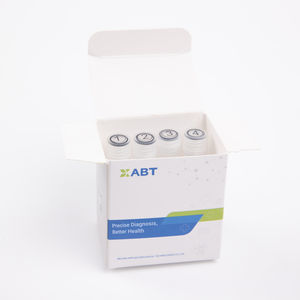
- Laboratory
- Laboratory medicine
- Rapid respiratory disease test
- BEIJING APPLIED BIOLOGICAL TECHNOLOGIES
Rapid respiratory infection test for antigensvirusSARS-COV-2
Add to favorites
Compare this product
Characteristics
- Applications
- for respiratory infections
- Tested parameter
- for antigens
- Micro-organism
- virus, SARS-COV-2
- Sample type
- clinical, laboratory
- Analysis mode
- for real-time PCR
- Result display time
15 min
Description
Respiratory infection diseases are common in adults and children, and most respiratory viruses have the potential to cause more than one type of respiratory disease, and the characteristics of
several types of viruses can be found in the same patient. In respiratory viral infection,
the correct differentiation of infected pathogens can help clinicians timely choose treatment options to avoid antibiotic abuse. Therefore, the laboratory diagnosis of respiratory virus infection is of great clinical significance.
Advantages
O Facilitates patient treatment decisions quickly
O Simple, time-saving procedure
O All necessary reagents provided & no equipment needed
O High sensitivity and specificity
Test Method
Samples preparation
1) Open the extraction reagent and drop all the liquid into the extraction tube.
2)lnsert the swab into the extraction tube which contains the extraction reagent. Rotate the swab inside the tube using a circular motion to roll the side of the extraction tube so that the solution is expressed and reabsorbed from the swab.
3)Pinch the extraction tube with fingers and elute the liquid on the swab as far as possible into the extraction reagent, then pull out the swab. The extracted solution will be used as test specimen.
4)Buckle the dripper.
Catalogs
No catalogs are available for this product.
See all of BEIJING APPLIED BIOLOGICAL TECHNOLOGIES‘s catalogsOther BEIJING APPLIED BIOLOGICAL TECHNOLOGIES products
Detection Kit
Related Searches
- Assay kit
- Blood assay kit
- Molecular biology reagent kit
- Infectious disease detection kit
- Blood rapid diagnostic test
- Diagnostic reagent kit
- Rapid lateral flow test
- Enzyme reagent kit
- Immunoassay rapid diagnostic test
- Molecular test kit
- Cassette rapid diagnostic test
- Rapid virus test
- Respiratory infection test kit
- Serum rapid diagnostic test
- Plasma rapid diagnostic test
- Clinical assay kit
- Infectious disease rapid diagnostic test
- Whole blood rapid diagnostic test
- Buffer solution reagent kit
- COVID-19 detection kit
*Prices are pre-tax. They exclude delivery charges and customs duties and do not include additional charges for installation or activation options. Prices are indicative only and may vary by country, with changes to the cost of raw materials and exchange rates.





